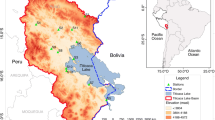Abstract
This paper examines the potential for the use of artificial neural networks (ANNs) to estimate the reference crop evapotranspiration (ET0) based on air temperature data under humid subtropical conditions on the southern coast of the Caspian Sea situated in the north of Iran. The input variables for the networks were the maximum and minimum air temperature and extraterrestrial radiation. The temperature data were obtained from eight meteorological stations with a range of latitude, longitude, and elevation throughout the study area. A comparison of the estimates provided by the ANNs and by Hargreaves equation was also conducted. The FAO-56 Penman–Monteith model was used as a reference model for assessing the performance of the two approaches. The results of this study showed that ANNs using air temperature data successfully estimated the daily ET0 and that the ANNs with an R 2 of 0.95 and a root mean square error (RMSE) of 0.41 mm day−1 simulated ET0 better than the Hargreaves equation, which had an R 2 of 0.91 and a RMSE of 0.51 mm day−1.






Similar content being viewed by others
References
Allen RG (1996) Assessing integrity of weather data for reference evapotranspiration estimation. J Irrig Drain Eng ASCE 122(2):97–106
Allen RG, Pereira LS, Raes D, Smith M (1998) Crop evapotranspiration: guidelines for computing crop requirements. FAO Irrigation and Drainage Paper No. 56. FAO, Rome, Italy
Amatya DM, Skaggs RW, Gregory JD (1995) Comparison of methods for estimating REF-ET. J Irrig Drain Eng 121(6):427–435
Berengena J, Gavilan P (2005) Reference evapotranspiration estimation in a highly advective semiarid environment. J Irrig Drain Eng ASCE 131(2):147–163
Choisnel E, de Viellele O, Lacroze F (1992) Une Approche Uniformisee du calcul de l’evapotranpiration Potentialle Pour l’ensamble des pays de la Communaut´es Europ´eene. Publication EUR 14223, Office des Publications Officielles des Communaut´e Europ´eene: Luxembourg
Coulibaly P, Anctil F, Bobee B (2000) Daily reservoir inflow forecasting using artificial neural networks with stopped training approach. J Hydrol 230(3–4):244–257
Cybenko G (1989) Approximation by superposition of a sigmoidal function. Math Control Signals Syst 2:303–314
Droogers P, Allen RG (2002) Estimating reference evapotranspiration under inaccurate data conditions. Irrig Drain Syst 16:33–45
Hargreaves GH (1994) Defining and using reference evapotranspiration. J Irrig Drain Eng 120(6):1132–1139
Hargreaves GL, Samani ZA (1982) Estimating potential evapotranspiration. J Irrig Drain EngASCE 108(3):225–230
Hargreaves GH, Allen RG (2003) History and evaluation of Hargreaves evapotranspiration equation. J Irrig Drain Eng ASCE 129(1):53–63
Hornik K, Stinchcombe M, White H (1989) Multilayer feedforward networks are universal approximators. Neural Network 2:359–366
Irmak S, Allen RG, Whitty EB (2003) Daily grass and alfalfa reference evapotranspiration estimates and alfalfa-to-grass evapotranspiration ratios in Florida. J Irrig Drain Eng 129(5):360–370
Jensen ME, Burman RD, Allen RG (1990) Evapotranspiration and irrigation water requirements. ASCE Manual and Rep. on Engrg. Pract. No. 70, ASCE, NY
Katul GG, Cuenca RH, Grebet P, Wright JL, Pruitt WO (1992) Analysis of evaporative flux data for various climates. J Irrig Drain Eng 118(4):601–618
Kosarev AN, Yablonskaya EA (1994) The Caspian Sea. SPB Academic, The Hague
Kumar M, Raghuwanshi NS, Singh R, Wallender WW, Pruitt WO (2002) Estimating evapotranspiration using artificial neural network. J Irrig Drain Eng 128(4):224–233
Martınez-Cob A (2002) Infraestimaci´on de la evapotranspiraci´on potencial con el m´etodo de Thornthwaite en climas semi´aridos. In: Cuadrat JM, y Vicente SM, Saz MA (eds) La Informaci´on Clim´atica Como Herramienta de Gestion Ambiental. Universidad de Zaragoza, Zaragoza, pp 117–122
Meyer SJ, Hubbard KG, Wilhite DA (1989) Estimating potential evapotranspiration: the effect of random and systematic errors. Agric For Meteorol 46:285–296
Odhiambo LO, Yoder RE, Hines JW (2001) Optimization of fuzzy evapotranspiration model through neural training with input– output examples. Trans ASAE 44(6):1625–1633
Rodionov SN (1994) Global and regional climate interaction: the Caspian Sea experience. Water Science and Technology Library, Kluwer Academic, Dordrecht
Sharma ML (1985) Estimating evapotranspiration. In: Hillel D (ed) Advances in irrigation, vol 3. Acain, London
Silva AF (2002) Previsao da evapotranspiracao de referencia utilizando redes neurais. Dissertacao de Mestrado, Univ. Federal de Vicosa, Vicosa, Minas Gerais, Brazil
Smith M, Allen R, Pereira L (1996) Revised FAO methodology for crop water requirements. In: Proceedings of the International Conference on evapotranspiration and Irrigation Scheduling, San Antonio, TX, USA, pp. 133–140
Sudheer KP, Gosain AK, Ramasastri KS (2003) Estimating actual evapotranspiration from limited climatic data using neural computing technique. J Irrig Drain Eng ASCE 129(3):214–218
Tahir SA (1998) Estimating potential evaporation using artificial neural network. In: Proceedings of the ICID 10th Afro-Asian Conference, Bali
Trajkovic S (2007) Hargreaves versus Penman-Monteith under humid conditions. J Irrig Drain Eng 133(1):38–42
Trajkovic S, Todorovic B, Stankovic M (2003) Forecasting of reference evapotranspiration by artificial neural networks. J Irrig Drain Eng ASCE 129(6):454–457
Utset A, Farre I, Martinez-Cob A, Cavero J (2004) Comparing Penman–Monteith and Priestley–Taylor approaches as reference evapotranspiration inputs for modeling maize water-use under Mediterranean conditions. Agric Water Manag 66(3):205–219
Vanderlinden K, Giraldez JV, Van Meirvenne M (2004) Assessing reference evapotranspiration by the Hargreaves method in southern Spain. J Irrig Drain Eng ASCE 130(3):184–191
Ventura F, Spano D, Duce P, Snyder RL (1999) An evaluation of common evapotranspiration equations. Irrig Sci 18:163–170
Xu CY, Singh VP (2001) Evaluation and generalization of temperature based methods for calculating evaporation. Hydrol Process 15:305–319
Zanetti SS, Sousa EF, Oliveira VPS, Almeida FT, Bernardo S (2007) Estimating evapotranspiration using artificial neural network and minimum climatological data. J Irrig Drain Eng 133(2):83–89
Author information
Authors and Affiliations
Corresponding author
Rights and permissions
About this article
Cite this article
Rahimikhoob, A. Estimation of evapotranspiration based on only air temperature data using artificial neural networks for a subtropical climate in Iran. Theor Appl Climatol 101, 83–91 (2010). https://doi.org/10.1007/s00704-009-0204-z
Received:
Accepted:
Published:
Issue Date:
DOI: https://doi.org/10.1007/s00704-009-0204-z




